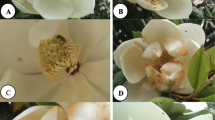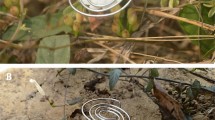Abstract
Context
Most studies assess pollination success at capsule maturity, and studies of pre-zygotic processes are often lacking.
Aims
This study investigates the suitability of controlled pollination for a potential forestry plantation species, Eucalyptus argophloia, by examining pre- and post-zygotic pollination success.
Methods
Pollen tube development, capsule set and seed set are compared following three-stop pollination, artificially induced protogyny (AIP), AIP unpollinated and open pollination. The fecundity of stored pollen was compared with that of fresh pollen.
Results
Three-stop pollination, AIP and open pollination had similar numbers of pollen tubes, but AIP unpollinated had none. Open pollination produced significantly more capsules and total number of seeds than the other treatments. There were significantly more seeds per retained capsule for the open pollination and three-stop pollination treatments than for the AIP and AIP unpollinated pollination treatments. There were no significant differences relative to the age of pollen.
Conclusions
Pre-zygotic success in terms of pollen tubes was similar for open-pollinated, three stop and AIP, but was not reflected in post-zygotic success when the open pollination and three-stop method produced significantly more seeds per retained capsule than the AIP treatments and open pollination yielded more seeds. Capsule set and total seed set for open pollination, and fewer capsules in controlled pollinations, may reflect physical damage to buds because of the small E. argophloia flowers. Suitable alternative breeding strategies other than controlled pollinations are discussed for this species.

Similar content being viewed by others
References
Abasolo M, Lee DJ, Shepherd M (2012) Identification of intersectional Corymbia hybrids based on seedling morphology improves with parental divergence. Forest Ecol Manag 279:189–202
Assis T, Warburton P, Harwood C (2005) Artificially induced AIP: an advance in the controlled pollination of Eucalyptus. Aust Forest 68:27–33
Barbour RC, Potts BM, Vaillancourt RE, Tibbits WN, Wiltshire JE (2002) Gene flow between introduced and native Eucalyptus species. New For 23:177–191
Barbour RC, Potts BM, Vaillancourt RE (2003) Gene flow between introduced and native Eucalyptus species: exotic hybrids are establishing in the wild. Aust J Bot 51:429–439
Barbour RC, Potts BM, Vaillancourt RE (2007) Gene flow between introduced and native Eucalyptus species: morphological analysis of tri-species and backcross hybrids involving E. nitens. Silv Genet 56:127–133
Brawner JT, Lee DJ, Meder AR, Almeida A, Dieters MJ (2013) Classifying genotype by environment interactions for targeted germplasm deployment with a focus on Eucalyptus. Euphytica 191:403–414
Brooker M, Kleinig D (1999) Field guide to eucalypts—volume 1 south-eastern Australia, 2nd edn. Bloomings Books, Melbourne, pp 70–186
Brooker M, Kleinig D (2004) Field guide to eucalypts—volume 3 Northern Australia, 2nd edn. Bloomings Books, Melbourne, p 240
Collins SL, Callister AN (2010) Genetic and environmental influences on capsule retention following controlled pollination of Eucalyptus globulus flowers. Aust Forest 73:198–203
Cotterill PP (1986) Genetic gains expected from alternative breeding strategies including simple low cost options. Silv Genet 35:212–223
Dickinson GR, Wallace HM, Lee DJ (2010) Controlled pollination methods for creating Corymbia hybrids. Silv Genet 59:233–241
Dickinson GR, Lee DJ, Wallace HW (2012) The influence of pre- and post-zygotic barriers on interspecific Corymbia hybridization. Ann Bot 109:1215–1226
Dickinson GR, Lee DJ, Wallace HW (2013) Reciprocal and advanced generation hybrids between Corymbia citriodora and C. torelliana: forestry breeding and the risk of gene flow. Ann Forest Sci 70:1–10
Ellis MF, Sedgley M, Gardner JA (1991) Interspecific pollen-pistil interaction in Eucalyptus L’Hér. (Myrtaceae): the effect of taxonomic distance. Ann Bot 68:185–194
Franklin EC (1986) Estimation of genetic parameters through four generations of selection in Eucalyptus grandis demonstrate valuable methodology. In: Proceedings of the International Union of Forest Research Organizations (IUFRO), Conference on Breeding Theory, Progeny Testing and Seed Orchards, Williamsburg, VA, pp 192–196
Gea LD, McConnochie R, Wynyard S (2007) Parental reconstruction for breeding, deployment and seed-orchard management of Eucalyptus nitens. New Zealand J Forest Sci 37:23–26
Griffin AR (1982) Clonal variation in radiata pine seed orchards. I. Some flowering, cone and seed production traits. Aust J Forest Res 112:295–302
Griffin AR, Burgess IP, Wolf L (1988) Patterns of natural and manipulated hybridisation in the genus Eucalyptus L’Hérit.—a review. Aust J Bot 36:41–66
Harbard JL, Griffin AR, Espejo J (1999) Mass controlled pollination of Eucalyptus globulus: a practical reality. Can J Forest Res 29:1457–1463
Horsley TN, Johnson SD (2007) Is Eucalyptus cryptically self-incompatible. Ann Bot-London 100:1373–1378
Horsley TN, Johnson SD, Stanger TK (2007) Optimum storage and in vitro germination of Eucalyptus pollen. Ann Bot 55:83–89
Horsley TN, Johnson SD, Myburg AA (2010) Comparison of different control-pollination techniques for small-flowered eucalypts. New For 39:75–88
Lee DJ, Huth JR, Osbourne DO, Hogg BW (2010) Selecting hardwood taxa for wood and fibre production in Queensland’s subtropics. Aust Forest 73:106–114
Lord E (2000) Adhesion and cell movement during pollination: cherchez la femme. Trends Plant Sci 5:368–373
Martin F (1959) Staining and observing pollen tubes in the style by means of fluorescence. Stain Technol 34:125–128
Ngugi MR, Hunt MA, Doley D, Ryan P, Dart P (2004) Selection of species and provenances for low-rainfall areas: physiological responses of Eucalyptus argophloia to seasonal conditions in subtropical Queensland. Forest Ecol Manag 193:141–156
Nichols JD, Smith RG, Grant J, Glencross K (2010) Subtropical eucalypt plantations in eastern Australia. Aust Forest 73:53–62
Patterson B, Gore P, Potts BM, Vaillancourt RE (2004) Advances in pollination techniques for large-scale seed production in Eucalyptus globulus. Aust J Bot 52:781–788
Pound LM, Wallwork MAB, Potts BM, Sedgley M (2002a) Early ovule development following self- and cross-pollinations in Eucalyptus globulus Labill. ssp. globulus. Ann Bot 89:613–620
Pound LM, Wallwork MAB, Potts BM, Sedgley M (2002b) Self-incompatibility in Eucalyptus globulus ssp. globulus (Myrtaceae). Aust J Bot 50:365–372
Randall BW, Walton DA, Lee DJ, Wallace HM (2012) Fertilisation and pollen tube development in Eucalyptus argophloia. Silv Genet 61:121–126
Rockwood DL, Warrag EE, Javenshir K, Kratz K (1989) Genetic improvement for Eucalyptus grandis for Southern Florida. In: Proceedings of the 20th Southern Forest Tree Improvement Conference, Charleston, SC, pp 403–410
Sedgley M, Smith RM (1989) Pistil receptivity and pollen tube growth in relation to the breeding systems of Eucalyptus woodwardii Maiden (Symphyomyrtus). Ann Bot 64:21–31
Sedgley M, Hand FC, Smith RM, Griffin AR (1989) Pollen tube growth and early seed development in Eucalyptus regnans F Muell. (Myrtaceae) in relationship to ovule structure and preferential outcrossing. Aust J Bot 37:397–411
Sokal R, Rohlf F (1995) Biometry, 3rd edn. W. H. Freeman and Company, New York
Suitor S, Potts BM, Brown PH, Gracie AJ, Gore PL (2008) Post-pollination capsule development in Eucalyptus globulus seed orchards. Aust J Bot 56:51–58
Tibbits WN (1989) Controlled pollination studies with shining Gum (Eucalyptus nitens (Deane & Maiden) maiden). Forestry 62:111–126
Trindade H, Boavid LC, Borralho N, Feijo JA (2001) Successful fertilization and seed set from pollination on immature non-dehisced flowers of Eucalyptus globulus. Ann Bot 87:469–475
Turnbull JW (1999) Eucalypt plantations. New For 17:37–52
Van Wyk G (1977) Pollen handling, controlled pollination and grafting of Eucalyptus grandis. South African Forest J 101:47–53
Wallace HM, Vithanage V, Exley EM (1996) The effect of supplementary pollination on nut set of Macadamia (Proteaceae). Ann Bot 78:765–773
White TL, Adams WT, Neale DB (2007) Forest genetics. CABI Publishing, Cambridge, MA
Williams DR, Potts BM, Black PG (1999) Testing single visit pollination procedures for Eucalyptus globulus and E. nitens. Aust Forest 62:346–352
Acknowledgments
The authors wish to thank the Australian Research Council for financial assistance, John Oostenbrink (Agri-Science Queensland, Gympie) for technical support and Agri-Science Queensland, Department of Agriculture, Fisheries and Forestry, for providing access to trial sites and equipment used in this study.
Funding
This work was supported by the Australian Research Council linkage grant number LP0562678.
Author information
Authors and Affiliations
Corresponding author
Additional information
Handling Editor: Ricardo Alia
Contribution of the co-authors
Bruce W. Randall: collaboratively designing the experiments, undertaking the experiments, collecting and analysing data and drafting and editing the manuscript.
David A. Walton: collaboratively designing the experiments and discussing, editing and submitting the manuscript.
David J. Lee: providing equipment and access to the experimental site, doing field work and reviewing the manuscript.
Helen M. Wallace: coordinating the project, collaboratively designing the experiments, supervising the experiments, discussing data and results and editing the manuscript.
Rights and permissions
About this article
Cite this article
Randall, B.W., Walton, D.A., Lee, D.J. et al. Comparison of three pollination methods for Eucalyptus argophloia, a small-flowered eucalypt. Annals of Forest Science 72, 127–133 (2015). https://doi.org/10.1007/s13595-014-0407-z
Received:
Accepted:
Published:
Issue Date:
DOI: https://doi.org/10.1007/s13595-014-0407-z




